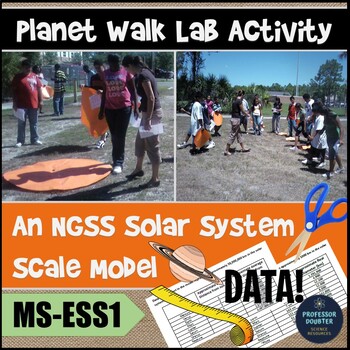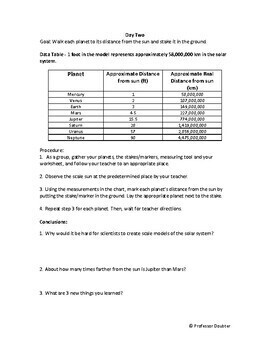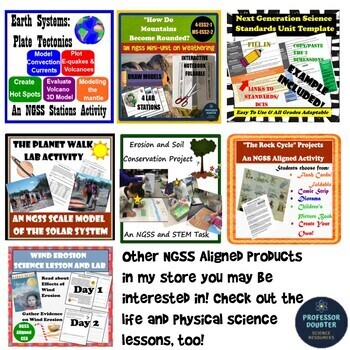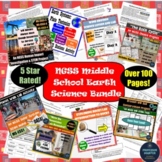Scale Model of Solar System Lab Activity NGSS Middle School MS-ESS1-2 MS-ESS1-3
- PDF
Also included in
- This NGSS Next Generation Science Standards for Middle School Science Mega Bundle has ALL of my NGSS labs, lessons, bulletin boards, posters, activities, assessments, projects, and other resources combined into one product (most of which have been or are being edited for distance learning) ! It offePrice $349.99Original Price $521.25Save $171.26
- This NGSS bundle for Middle School Science is a bundle of all of my EARTH science/geology labs, lessons, worksheets, and activities combined into one product at a DISCOUNT! All resources are aligned to the new NGSS standards and are sure to fit perfectly into your earth science or geology units! ItPrice $59.00Original Price $77.25Save $18.25
Description
TRY ME FOR FREE!!!! This NGSS aligned two-day lab activity is a FUN, EYE-OPENING, and mathematically accurate way to model planet size and orbits in our solar system and incorporate the Performance Expectations for MS-ESS1: MS-ESS1-2. Develop and use a model to describe the role of gravity in the motions within galaxies and the solar system and MS-ESS1-3. Analyze and interpret data to determine scale properties of objects in the solar system as well as the Crosscutting concept of Scale, Proportion, and Quantity. Students use the Science and Engineering Practice of Analyzing and Interpreting Data to create a scale model
(Scale, Proportion, and Quantity) of the sizes and orbits of the planets and the sun and take them to a large area to "WALK THEM!!!"
My students are always shocked to see just how different in size and distance each planet is to one another! Ideally, it could be used within an astronomy unit after students have an understanding of the unique differences between the planets but can be taught at any point in the unit even as the hook at the very beginning. It provides students with data on the sizes of the planets as well as their distances from the sun using units that are measurable on earth. Students measure, create, and "walk" the planets outside to model the sizes and distances from one another. Truly eye-opening! NOTE: The sun is just too big to make with paper, but it's super cool for the students to discover this on their own in the activity!
Looking for ways to assess student understanding of the NGSS on tests, pre-assessments, exit tickets, etc.? Then, check out my newest line of NGSS Assessment Questions here: NGSS Assessments and Task Questions
Let’s Connect!
Follow my store at this link to stay up-to-date on my latest NGSS resources! Click here!
Are you on Facebook? Be sure to follow me on Facebook for NGSS FREEBIES, updates on what I’m working on, and of course, science memes! Professor Doubter's Facebook Page
Interested in other Earth Science/Geology products?
Erosion and Soil Conservation STEM Project
Weathering Mini Unit/Investigation
Looking for other science resources: NGSS lessons, units, activities, templates, etc.? Check out my store for more here: Store Link.
STEM Challenges For Every Month
First Day of School STEM Name Tag Design
Synthetic and Natural Resources STEM Project
Modeling Analog and Digital Signals
Introduction to Waves Activity
Modeling Reflection of Light Lab
Prevent a Chemical Change With Pennies Lab
Magnetic Fields and Eating Nails For Breakfast Lab
Modeling Particle Motion, State, and Temperature Lab
Physical and Chemical Changes Minilabs
Dry Ice Demonstration on Sublimation
Potential and Kinetic Energy Worksheet
Modeling Compounds and Molecules with Fasteners
Rutherford's Discovery of the Nucleus Lab (FREE)
Maintaining Biodiversity Activity
Modeling Food Chains and Food Webs Affected by the BP Oil Spill
Living Things are Made of Cells Online Investigation
Modeling Cell Organelles with Analogies
Natural Selection Butterfly Lab
Resource Availability in Ecosystems Activity
Gathering Evidence for Photosynthesis Lab
Adaptations and Biomimicry STEM Lab
NGSS Unit Template for Planning (Example Included)
Looking for other NGSS lessons, units, activities, etc.? Check out my store for more here: Store Link.
Buy the bundle and have access to all NGSS resources!
NGSS Physical Science Bundle: Click Here
NGSS "Waves" Bundle: Waves Bundle
NGSS Life Science Bundle: Click Here
NGSS Earth Science Bundle: Click Here
NGSS All Resources Bundle: Click Here
Feel free to share my website with colleagues. Each purchase is a license for ONE person to use in a classroom setting per my Terms of Use. Distribution or sharing of any products are in violation of copyright law.
If you're new to NGSS, check out my other NGSS lessons in my store! FREE!! Try out my NGSS lesson and if you like it, PLEASE RATE ME to earn TPT credits :) I would LOVE your feedback!







